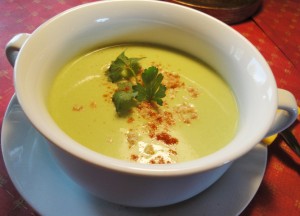It’s January and winter is in full blast around the country. Right now, my Colorado Rocky Mountains are getting pummeled with snow measured in feet, not inches. Temperatures dip into the single digits at night. And, since it’s late January, we are about 3 weeks into those pesky New Year’s resolutions….which hopefully included eating more vegetables. What better way to warm the soul this winter and eat more vegetables than a creamy, soul-satisfying vegetable soup.
Soups seem innocent enough, but creamy soups are often huge stumbling blocks because the thickening usually comes from wheat flour. What can you use instead of wheat flour to get that same gratifying creaminess?
I like to experiment with various ways to achieve this desired creaminess, but one of the easiest and most effective ways is to simply cook a little chopped raw white potato along with the vegetables. The starch from the potatoes thickens the soup nicely, without changing its flavor or color?as this creamy broccoli soup illustrates.
Cream of Broccoli Soup
Adapted with permission from 125 Gluten-Free Vegetarian Recipes (Avery/Penguin Group, 2011)
A lovely shade of light green, this soup packs a wallop of nutrients from broccoli, a member of the cruciferous family. The potato and coconut milk lend creaminess. The soup is vegan, but you can sprinkle a bit of crumbled cooked bacon or prosciutto on top for the meat-eaters in your family.
Serves 6; Makes 8 cups
2 tablespoons butter or buttery spread
1 large shallot, finely chopped
2 whole garlic cloves, minced
1/2 cup Russet potato, peeled and chopped
1 bunch broccoli florets, about 3 cups
6 cups GF vegetable broth (I use Imagine No-Chicken or make your own)
1/2 teaspoon sea salt
1/4 teaspoon freshly ground black pepper
1/2 cup coconut milk or plain coffee creamer (soy or coconut)
1/8 teaspoon freshly ground nutmeg
2 tablespoons fresh lemon juice
Salt and freshly ground black pepper to taste
Fresh chopped parsley or chives, for garnish
Dash of paprika, for garnish
[1] In a large pot, melt the butter over medium heat and cook the shallots until tender, about 2 to 3 minutes. Add the garlic and potato and toss to coat with butter. Add the broccoli, broth, salt, and pepper and bring to a boil. Reduce the heat to low and cook, covered, until the potato and broccoli are tender, about 15 to 20 minutes.
[2] Place half of the soup in a blender, add half of the coconut milk, and puree in a blender or food processor until very smooth. Repeat with remaining soup and creamer. Return the soup to the pot and add nutmeg, lemon juice, and more salt and pepper, if desired. (Or, use an immersion blender to puree the soup.) Bring to serving temperature over medium heat, stirring constantly. Serve hot, garnished with a sprinkle of parsley or chives and a dash of paprika.
Carol’s Additional Tips for Thickening Soups
[1] Potatoes are excellent natural thickeners, but you don’t have to use raw potatoes. Leftover mashed potatoes thicken soups nicely; about one-half cup should thicken a recipe that serves 4 but you may need to experiment a bit depending on the soup. This method works best when you puree the soup to a smooth texture before serving. You can also use instant potato flakes; stir in a teaspoon at a time just before serving until the desired consistency is reached. Or, use one and one-half teaspoons potato starch for every tablespoon of wheat flour in your recipe. Be sure to stir the potato starch into a little water to create a “slurry” so it doesn’t clump when you stir it into the hot soup.
[2] Rice is another good thickener. Cream of Rice baby cereal flakes works well. Add a teaspoon at a time just before serving until you get the desired consistency. You can also cook one-quarter cup white rice with the vegetables and then puree the whole mixture. One of my favorite thickeners is sweet rice flour, made from the same sticky rice served in Asian restaurants. It produces a creamy, slightly opaque look that looks a lot like soup thickened with wheat flour. Use the same amount as wheat flour; stir it into a little cold water to make a “slurry” and then stir into the soup just before serving.
[3] Plain soy creamers (I prefer Silk soy or So Delicious coconut because they have the fewest ingredients) lend creaminess and pleasant mouth-feel. Add them just before pureeing (to cool down the hot soup in the blender) or just before serving for non-pureed soups. Canned coconut milk also works well.
[4] For some soups, pureeing just part of the soup (perhaps one-quarter of it) in a blender and then adding the puree back into the pot will provide just enough thickening. I use this method often with potato soup or bean soup for an extra touch of creaminess. A hand-held, immersion blender is another great tool for pureeing part of the soup as it sits in the pan. An even simpler method is to use a potato masher to mash part of the soup as it sits in the pan, then stir to distribute the pureed portion evenly throughout the soup.
[5] Wondering about that old standby, cornstarch? Cornstarch can be used to thicken soups, but it will create a shiny, slightly transparent look that more resembles a sweet dessert sauce than a savory soup. I rarely use it in soups for that reason. Same for arrowroot, although some experts use a little arrowroot to make foods shine just a bit (so they look like they have more fat than they actually do).
[6] Finally, you may need to experiment a bit with each of these thickeners to reach the desired effect. Sometimes the success of these techniques varies with the type of recipe. When trying these tips with your own soup recipes, write down what you did in the margins of your recipe or cookbook so you can replicate your successful results again.








